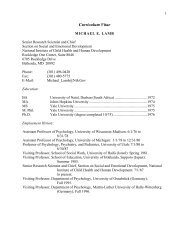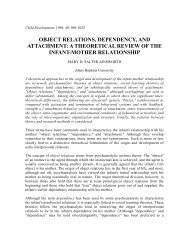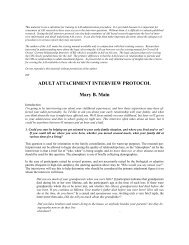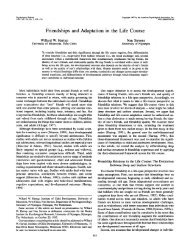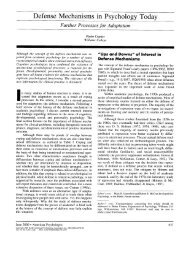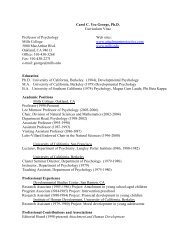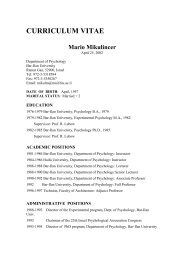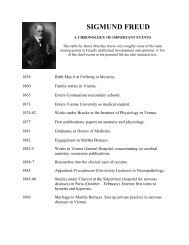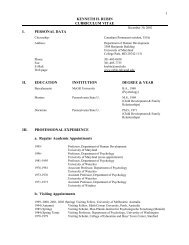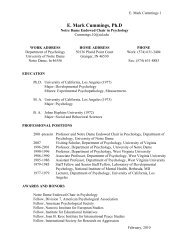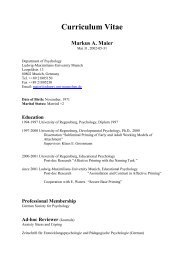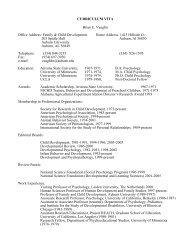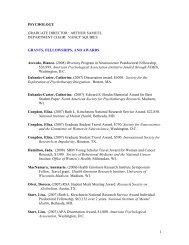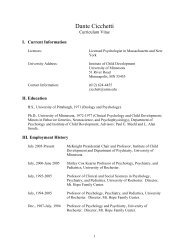the origins of attachment theory: john bowlby and mary ainsworth ...
the origins of attachment theory: john bowlby and mary ainsworth ...
the origins of attachment theory: john bowlby and mary ainsworth ...
Create successful ePaper yourself
Turn your PDF publications into a flip-book with our unique Google optimized e-Paper software.
development, as in filial, parental, <strong>and</strong> sexual imprinting.<br />
Having laid out this general <strong>the</strong>ory <strong>of</strong> motivation <strong>and</strong> behavior regulation in <strong>the</strong> first half <strong>of</strong><br />
<strong>the</strong> volume, Bowlby goes on, in <strong>the</strong> second half, to apply <strong>the</strong>se ideas to <strong>the</strong> specific domain <strong>of</strong><br />
infant-mo<strong>the</strong>r <strong>attachment</strong>. He defines <strong>attachment</strong> behavior as behavior that has proximity to an<br />
<strong>attachment</strong> figure as a predictable outcome <strong>and</strong> whose evolutionary function is protection <strong>of</strong> <strong>the</strong><br />
infant from danger, insisting that <strong>attachment</strong> has its own motivation <strong>and</strong> is in no way derived from<br />
systems subserving mating <strong>and</strong> feeding.<br />
Although human infants initially direct proximity-promoting signals fairly indiscriminately to<br />
all caregivers, <strong>the</strong>se behaviors become increasingly focused on those pri<strong>mary</strong> figures who are<br />
responsive to <strong>the</strong> infant’s crying <strong>and</strong> who engage <strong>the</strong> infant in social interaction (Schaffer &<br />
Emerson, 1964). Once attached, locomotor infants are able to use <strong>the</strong> <strong>attachment</strong> figure as a<br />
secure base for exploration <strong>of</strong> <strong>the</strong> environment <strong>and</strong> as a safe haven to which to return for<br />
reassurance (Ainsworth, 1967; Schaffer & Emerson, 1964). How effectively <strong>the</strong> <strong>attachment</strong><br />
figure can serve in <strong>the</strong>se roles depends on <strong>the</strong> quality <strong>of</strong> social interaction-especially <strong>the</strong><br />
<strong>attachment</strong> figure’s sensitivity to <strong>the</strong> infant’s signals-although child factors also play a role.<br />
Building on Ainsworth’s G<strong>and</strong>a study (1967) <strong>and</strong> preliminary findings from her Baltimore<br />
project, Bowlby (1969) comments that:<br />
when interaction between a couple runs smoothly, each party manifests intense pleasure in<br />
<strong>the</strong> o<strong>the</strong>r’s company <strong>and</strong> especially in <strong>the</strong> o<strong>the</strong>r’s expression <strong>of</strong> affection. Conversely,<br />
whenever interaction results in persistent conflict each party is likely on occasion to exhibit<br />
intense anxiety or unhappiness, especially when <strong>the</strong> o<strong>the</strong>r is rejecting. Proximity <strong>and</strong><br />
affectionate interchange are appraised <strong>and</strong> felt as pleasurable by both, whereas distance <strong>and</strong><br />
expressions <strong>of</strong> rejection are appraised as disagreeable or painful by both. (p. 242)<br />
During <strong>the</strong> preschool years, <strong>the</strong> <strong>attachment</strong> behavioral system, always complementary to<br />
<strong>the</strong> parental caregiving system, undergoes fur<strong>the</strong>r reorganization as <strong>the</strong> child attains growing in-<br />
sight into <strong>the</strong> <strong>attachment</strong> figure’s motives <strong>and</strong> plans. Bowlby refers to this stage as goal-<br />
corrected partnership. However, in emphasizing infant initiative <strong>and</strong> sensitive maternal respond-<br />
ing, Bowlby’s (1951) earlier <strong>the</strong>orizing on <strong>the</strong> mo<strong>the</strong>r as <strong>the</strong> child’s ego <strong>and</strong> superego was re-<br />
grettably lost.<br />
Consolidation



